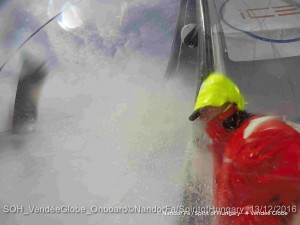The wind gauge is indicating 40 knots. It suddenly got up. The boat accelerates violently. The shrill sound from the keel gets even more piercing. The boat slides down a wave like a toboggan on the snow. Inside you start to worry. You feel like you’re being carried away with no brakes to apply. What will happen in the end? You hold on tight, with tense muscles and clench up You wait for the slam. Your mouth goes dry, you go into a cold sweat, your throat goes tight and there is an adrenalin rush.
The bow hits the bottom of the wave and buries itself in the green water. You hold on to prepare for the sudden braking. If you get thrown around, it will be terrifying. There are more worrying groans from the hull, which undergoes huge stresses and strains. Outside, the mast appears to have made it through. You think of all the tiny parts that may have suffered. One of them breaking could mean the house of cards tumbles down. You think of all those who gave it their all on this boat and worked to ensure she would survive.
In spite of the tension of these high speeds, speed is what is required to get through these waves and limit the thrust on the sails. That is a possibility on these boats piloted by electronics, which are able to anticipate the trajectory. A very different story from the older boats that first sailed in these latitudes. You look like Yves Montand in the famous film, “The Wages of Fear” (or Roy Scheider in Sorceror, if you prefer). Here, waves replace the dirt track and the nitroglycerine is replaced by the rigging. The worry is the same. Avoid slowing down to avoid an explosion. As for fear and wages, we can talk about that after Cape Horn, but the bill looks like it’s going to be expensive.
People say you have to be crazy to come down here on these huge seas. But you only pass through these waters, where the ocean is the Master. Better respect the Forties than show your arrogance. Once again, you accelerate away suddenly, but it is not as brutal this time. In addition to the Antarctic lows, occasionally some move in from the north too. They create those mountainous waves and circle the bottom of the Earth. The danger arises when there are cross seas and rogue waves appear. You need to trim, so first you have to dress for the occasion. It I scold inside and as wet as outside. So you sleep in your underwear and a fleece with a hat and socks. You sometimes start the engine to recharge your batteries and warm your body. You put on your waterproof suit, the third layer. The first layer – underclothes made of polyester which help remove sweat. A dry body loses less heat. The second layer in synthetic fibre has a different role – it captures theair, drains the sweat and creates a cocoon around the body. The top layer is water repellant, protecting you from the spray and wind. This three layer sandwich is there to protect you.
After a few contorted movements, you clip on. Make sure the cuffs and neck are adjusted. Ouside it’s winter, but in fact, no, this is summer down here with very short nights. But the gusts arrive from the Antarctic freezer, and someone has forgotten to shut the door. The cold is penetrating and the wind is more powerful. That is one of the characteristics of the Southern Ocean. With a temperature of 2°C and a wind in excess of 35 knots, it feels like a temperature of around -6°C. So you work quickly, keeping an eye out to watch the waves coming. Look out! There’s one just now breaking over the coach roof. If you hadn’t seen it coming, you would have been soaked and wet clothes are impossible to dry down here.
The gloves slip on the soaked sheets. You’ve no other choice but to take them off. When they come into contact with the wind and water, your hands feel the cold and immediately go numb. It hurts. A tingling sensation with cramps paralysing the fingers. Not surprising really. In water, heat is thirty times more quickly than in the air. In order to ensure that the body does not lose all its heat, it has its own way of dealing with this. It hides inside itself to get way from the outside world. The small blood vessels under the skin fulfil this role. They contract, so that a minimum of blood is in contact with the outside. The human being is a warm-blooded creature, which works at around 37°C and cannot stand to be much colder or warmer. This chilled blood could cause the body not to work properly. The heart, for example.
That’s it for the manoeuvres. Time for a quick tidy up. The body has resisted the cold. Your fingers no longer have any blood, and look white, stiff and weak, as if anaesthetised. You need to watch out for injuries and chapped hands. The hands themselves are swollen. The watertight cuff was probably too tight, acting as a tourniquet stopping the blood from flowing back. loosen it slightly, please. On the deck, you work on some final adjustments watching how the boat reacts. As you are not moving, the cold appears to take over your body. When you working hard, you coped with it. The muscles are excellent heaters, which produce four times as much heat as strength. Now that you are no longer moving, you start to shiver. These shivers are the first symptoms of the body suffering from the cold. by provoking uncontrollable muscular spasms, the body steps up its heat production to ward off the cold and keep you at the right temperature.
Finally, the boat is on the right course and the autopilot is set. You hurry back down below to get out of the wind. A few movements of the arms and legs to get the circulation going again. Your feet feel like blocks of ice. The blood slowly returns to the hands. The skin is red and burning, as if the blood was finding it difficult to find its way through this epidermis turned rigid by the cold.
A nice, warm bowl of soup. The fingers are still clumsy, as you turn on the hot plate. But now it’s over. The gentle heat of the flames radiates on your face and hands. It certainly feels good. After the soup, time for a bowl of dried noodles. It’s very quick and rich. Here your daily calorie intake is around 6000 calories. If the temperature falls by ten percent, you require five percent more calories. So, if you are still hungry or haven’t eaten enough, don’t worry. You are a store cupboard with all the fat that you have added so easily to your body’s reserves and which people are so keen to get rid of. Yet, in fact, this age-old reflex to store fat, which has been passed down in your genes, would have saved your life in times of famine. But in modern times, where we have plenty to eat, excess is considered normal. Our genes haven’t yet learnt to adapt to that. So the 100,000 calories in our body, which represents 20% of our bodies should be sufficient to deal with that perfectly well.
So the boat surfs along again. Keep calm and trust. In order to sail in these hostile latitudes, the challenge is simple. Keep a cool head, while keeping as warm as you can.
Dr Jean-Yves CHAUVE
Source: Vendee Globe








